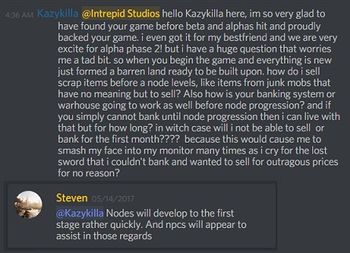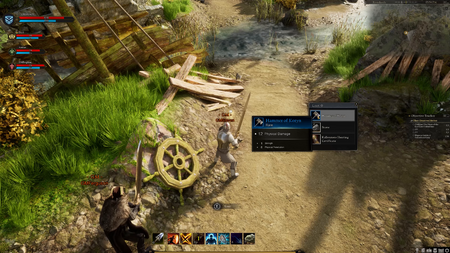| Glorious Wiki readers. We are adding the Midnight Magic video and livestream to the wiki. We appreciate your patience as we process the new and updated information! |
World manager
The World manager is an algorithm in Ashes of Creation that controls dynamic world elements. It acts as both a throttle and an incentive system for various activities to ensure certain parameters are within acceptable thresholds.[1]
- A world manager is a technical term to define a server process that lives alongside the game server; and when the game server needs to do things- communicating with other game servers within that grid- it tells that manager and that manager sends it down to the appropriate server.[2] – Steven Sharif
- Prices of glint.[3]
- A heatmap of experience being gained to apply to node advancement.[3]
- The territory expansion algorithm takes into account the nearest coast, neighboring nodes, and the heatmap of players in surrounding areas over the last weeks or month.[4]
- Due to the way the progression algorithm calculates territorial (ZOI) expansion during node advancement, there is a small possibility that two nodes of the same stage end up being close to each other.[5]
- Transit of resources and goods between regions to drive quest rewards for nodes.[3]
- For example if you know iron is being used as a raw resource for a specific crafting path that might drive up the price of mithril or silver; and that will incentivize the market to course correct a little bit. The idea is to provide soft incentives that help to alleviate the demand and also to prop up the supply that might not be present from the economic systems.[3] – Steven Sharif
Node advancement
Citizen and non-citizen player activity (questing, gathering, raiding, etc.) within a node's ZOI counts toward that particular node's advancement (progression) to a higher node stage.[7][8]
The advancement of a node unlocks its unique content, which comes at the cost of locking out an increasing ring of neighboring nodes from progressing to the next stage.[9]
- Nodes advance to the first stage quickly. This enables NPC services such as vending or banking items.[10]
- The more advanced the node is, the larger its ZOI becomes.[11]
- Less advanced nodes (referred to as vassal nodes) that fall within a more advanced node's ZOI can still gain XP, but must remain at a lower advancement stage than the dominant node.[12]
- The vassal system begins when a node hits Village (stage 3), but neighboring nodes starting from Expedition (stage 1) also block the growth of their immediate neighbors.[13][14]
- Certain quests, such as story arcs, may not be able to be turned in after a node has advanced.[15]
- The territory expansion algorithm takes into account the nearest coast, neighboring nodes, and the heatmap of players in surrounding areas over the last weeks or month.[4]
- Due to the way the progression algorithm calculates territorial (ZOI) expansion during node advancement, there is a small possibility that two nodes of the same stage end up being close to each other.[5]
- The way that the algorithm expands the territories takes into account a few things: One it takes into account the coast like where's the closest coast. Two it takes into account the neighboring nodes so it can take over and essentially vassal state those nodes, but what's more important is essentially the initial population based on like how players choose their races. Because we have nine different races and four different starting points that branch out, each server's population density is going to dictate essentially the first few nodes that are highly populated and then that initial seed is what's going to determine the node structure as it moves inland into the into the world essentially; and based on the performance and successes of different sieges will determine which nodes that got locked out from the previous the initial advancements what nodes can now be available to advance further. So I really think that with so many variables that are present in the equation of how nodes advance and stay existing with the more variables you have, the higher likelihood there is for there to be a significant diversion in world progression.[4] – Steven Sharif
- Normally the algorithm that's applied to the node territorial expansion will prevent significant nodes from being in close proximity to each other... There could be a perfect storm where all of the algorithmic progression of territory leads to having these nodes very close to each other because there's certain requirements that should that need to be available to satisfy node vassal takeovers; and it's possible that two nodes would never take each other over as vassals and end up close together and spanning their territories in opposite directions: The Tale of Two Cities thing.[5] – Steven Sharif
- A node does not receive XP from the nodes within its ZOI until these nodes have reached their cap.[12]
- Node experience gain opportunities will be equitable across the four node types.[17]
- Different people have different resources invested in nodes progressing and it would be a little "gamey" if you could know exactly what was necessary at that point because that would disincentivize people from participating.[18] – Steven Sharif
Node advancement spawns a series of animations and visual effects (within the footprint of the node).[19][7]
- Players within the node are teleported to a safe location, likely a respawn area near the node.[19][20]
- Supplies will spawn around the node and system driven caravans are spawned to bring these supplies into the node. These caravans are not able to be attacked.[19]
- NPCs will begin construction activities.[19]
- Players outside the node will see the new facade of the node pop into existence as the node advances in stage.[19]
- The Development Area of a Node is where civilization will appear as the Node advances. As the Node Stage increases, different buildings, NPCs, and services will become available in the Development Area. The higher the Node Stage, the more complex and populated the Development Area becomes. Development Areas will also vary depending on the Node Type - Economic, Military, Scientific, or Divine.[7] – Margaret Krohn
Loot tables
- Mobs drop glint, Items, and crafting materials in preference to gold.[22][23]
- Glint is not bound to a specific region and can be also dropped by players on death as stolen glint, based on applicable death penalties.[24][25][26][27][22][28]
- The rarity of glint increases with the mob's level.[29]
- Loot tables are disabled for player controlled monsters.[30]
- There is a small RNG chance of looting rare and legendary items or crafting materials from mobs based on the level, status and type of mob. This also applies to harvesting resources with a gathering profession.[31]
- Experience debt decreases the drop rate percentages from monsters.[32]
- Loot (loot tables) from world bosses or dungeon bosses has a small RNG chance of dropping gear (completed items).[33][34]
- There is a much higher chance that materials and unique recipes are dropped that can be used to craft items of equitable value.[33][35][36]
- Legendary equipment is only dropped by Legendary world bosses.[37]
- Loot tables will likely not be affected by weather conditions.[39] This was previously listed as a possible effect.[40]
- There won't be specific loot drops for artisans.[41] Previously it was stated that master gatherers may have the ability to "spoil" a boss' loot.[42]
- Q: Can only one gathering artisan harvest resources from a single boss, or can multiple different artisans harvest different parts from a boss for different resources? For example, a lumberjack gets a special wood from Tumock's tree weapon, while a herbalist gathers the flowers from that same tree.
- A: We don't have the concept of harvesting from bosses. NPCs follow a reward table format, where those reward tables are global. They're not unique to particular players. So, once the NPC is vanquished, you have access to the loot container that is its corpse; and it has a static value of either materials or items that get dropped; and whatever the party loot settings are that you might be a part of, or if you're a solo player you will be able to recover those things.[41]
Population based scaling
The prices that NPCs sell items for will scale based on the economic activity on a server. Prices will rise to combat inflation and fall as a population diminishes.[43]
The node system allows the developers to scale the experience needed to level a node and the attrition that affects a node based on activity.[43]
Things that NPCs buy and sell scale based on the economic activity that exists on that server... As inflation rises, prices rise and everything ends up being equal, even though there might be a couple of extra zeros. So that can go up and it can also go down so as a population leaves, things become less expensive and players don't have to do as much to earn that. On the other side of things we look at the node system and the node system is set up in this really flexible way that allows us to scale the experience needed to level a node and the attrition that delevels a node to scale based on activity too. So it's just a matter of adjusting a couple of constants and that goes up and down and the server can watch it and change those on the fly as it needs to.[43] – Jeffrey Bard
See also
References
- ↑ Interview, July 19, 2020 (1:10:55).
- ↑ Livestream, October 14, 2022 (57:22).
- ↑ 3.0 3.1 3.2 3.3 Interview, July 19, 2020 (1:08:22).
- ↑ 4.0 4.1 4.2 Interview, July 18, 2020 (10:04).
- ↑ 5.0 5.1 5.2 Interview, July 8, 2020 (1:00:15).
- ↑ Video, February 29, 2024 (33:57).
- ↑ 7.0 7.1 7.2 Blog - Know Your Nodes - Advance and Destroy.
- ↑ A reactive world - Nodes.
- ↑ Video, April 20, 2017 (0:02).
- ↑

- ↑ Node series part II – the Metropolis.
- ↑ 12.0 12.1 Livestream, October 16, 2017 (50:20).
- ↑

- ↑

- ↑ Livestream, February 29, 2024 (53:58).
- ↑

- ↑ Livestream, September 24, 2021 (1:21:23).
- ↑ 18.0 18.1 Livestream, May 26, 2017 (28:16).
- ↑ 19.0 19.1 19.2 19.3 19.4 Livestream, October 14, 2022 (55:13).
- ↑ Livestream, November 17, 2017 (55:27).
- ↑ Video, January 27, 2023 (16:44).
- ↑ 22.0 22.1 Interview, July 18, 2020 (27:11).
- ↑ Livestream, May 24, 2017 (44:14).
- ↑

- ↑ Interview, September 10, 2023 (53:47).
- ↑ Livestream, March 26, 2021 (1:07:33).
- ↑

- ↑ Podcast, May 5, 2017 (43:05).
- ↑

- ↑ Livestream, May 3, 2017 (35:25).
- ↑ Interview, July 18, 2020 (1:00:15).
- ↑ Ashes of Creation Forums - Former Lineage 2 PvP'er wanting to discuss PvP loopholes.
- ↑ 33.0 33.1 Interview, July 19, 2020 (8:43).
- ↑ February 8, 2019 - Questions and Answers.
- ↑ Interview, July 20, 2020 (21:57).
- ↑ Livestream, 2018-04-8 (PM) (55:49).
- ↑ Livestream, July 25, 2020 (46:08).
- ↑ Livestream, December 22, 2020 (1:15:01).
- ↑ Livestream, May 27, 2022 (1:14:46).
- ↑ Video, May 27, 2022 (2:21).
- ↑ 41.0 41.1 Livestream, February 29, 2024 (1:22:09).
- ↑ Podcast, August 4, 2018 (1:44:54).
- ↑ 43.0 43.1 43.2 Livestream, June 4, 2018 (39:15).

